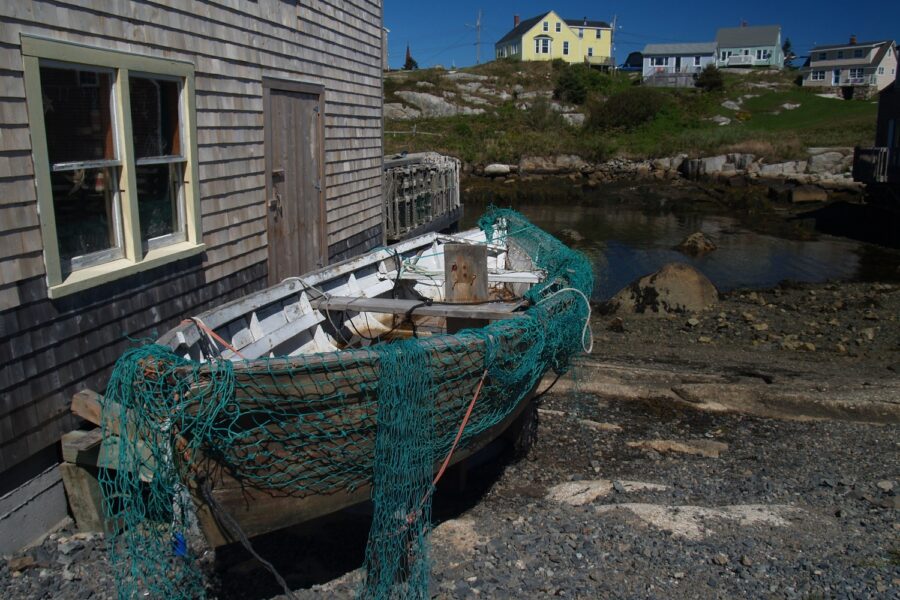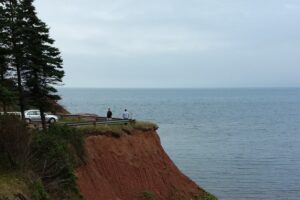I first heard of Peggy’s Cove in Nova Scotia last summer, when a ten-best list popped up on my Yahoo homepage. It was the ten best, must-see fishing villages of North America. Peggy’s Cove was close to the top of the list. I envisioned it as a sleepy little place with salt spray, fishing nets scattered around the rocks, lobster boats in the harbor, and very few people — a restaurant wasn’t even in that imagined place — in my mind’s eye it was way too small — way too off the beaten path. It immediately went on my wish list of places to see.
Peggy’s Cove – Not What I Expected
Arriving at this tiny community on St. Margaret’s Bay we are immediately greeted with two large parking lots — one close by, one on top of the hill near the lighthouse — both of them full of cars and tour buses. We choose to walk up the hill and park beside a large welcoming visitor’s center as we enter this bustling place seemingly crawling with people. None of them fishermen — all of them tourists. My imagined quaint, out-of-the-way, sleepy village evaporates before my eyes.


Peggy’s magic spell is not easy to define. It’s compounded of light and shadow and unchanging stone and ever-changing sea; of sun and fog and silence and booming surf; of small neat homes and small brave boats and lobster traps and nets; of weather-beaten faces and work-hardened hands and struggle and contentment.
And there are other things — white gulls wheeling in the blue sky and the sharp smell of fat mackerel pickling in tubs of brine and the green seaweed sprouting from the wet timbers of the jetties; the patient plodding of oxen and the quick artistry of women’s fingers hooking gay rugs; the legends and faith and humor and dignity of people who dwell by preference in a remote unhurried little world of their own and win their livelihood from the Atlantic.
AUGUST 1 1947 | IAN SCLANDERS | Maclean’s
I try to find a history of the cove and its original inhabitants in one of the many gift shops that populate the village but come up empty. Almost empty. I find instead a softcover book of beautiful photographs. It shows me the fishing village — clinging to the rocks — of my imagined dreams.
Now I sit here in the middle of the cove and wonder —
Why This Barren Rock?
The world wants to know how Peggy’s Cove got its name. I want to know what possessed the first settlers who came here to stay and call this barren rock home. The shores that stretch beyond Peggy’s Cove are softened and sheltered with welcoming trees; why not choose soft green shade rather than hard gray stone?






This place is naked. Vulnerable. Starkly beautiful in sunlight, it must be forbidding and unforgiving in a storm. Peggy’s Cove is a place, it seems, where the wrath of the sea would diminish and destroy everything in the wake of its fury. I am chilled to the bone thinking about living here in the ice and snow of the land, and the wind and wrath of the sea.
The Atlantic can be a vile-tempered old hellcat and often she pounds the rocky coast of Nova Scotia with waves that roar like thunder. One night at Peggy’s Cove, 30 miles south of Halifax, she bounced a 60-ton boulder around the front yard of the lighthouse. Then she thrust an arm up through the village, tore the general store off its foundations and lifted it, crushed it, dragged it, dropped it. When dawn came up and the sea calmed down it was obvious that the poor wreck of a building would never again be fit for its original purpose.
AUGUST 1 1947 | IAN SCLANDERS | Maclean’s
A Perfect Picture of Peggy’s Cove Lighthouse
We clamber over the enormous outcropping of giant slabs of granite where, today, they are kissed by gently rolling seas. Michael is looking for the perfect location, for the perfect picture, of the perfectly maintained lighthouse.
I sit staring at the rocks, at the lighthouse, surrounded by a day so brilliantly blue it is almost blinding. I still wonder — why the village? Why this place? I tell Michael, “It’s as if the first people who came and built a home here, looked out at the ocean and said, ‘I dare you. Just try to destroy me — I can take it!’”
Still thinking of his perfect picture he says, “Now if only all of those people will get out of the way.”


We settle ourselves in the arms of the rocks and wait. Originally I felt the same way about the people marring our perfect view; now I look at them as part of what this place is; apparently, tourists have been coming here since 1937. Today, even though it is still a fishing village, the rocky terrain is dotted with many homes turned into galleries, souvenir shops, restaurants, and B&B’s. I struggle with my photographs, trying to keep the new at bay and capture the old. It is a challenge. Michael has been doing a much better job.



A bagpipe wails.
Patience is rewarded, Michael gets his perfect shot when a woman, sporting a cane, asks a group of five, who have lingered over-long, to please move out of the way so she can take a picture. His camera clicks — several times. The bagpipe continues to keen its haunting tune.

I Still Wonder – Why?
We leave our perch and head to the coffee shop in search of a warming drink; the sunny September wind having sufficiently chilled our bones. We take our cappuccino to a group of nearby benches and continue our thoughtful pursuit of Peggy’s Cove’s origin. I Google. I search. Perhaps I need more than my smartphone provides.
Perhaps I’ll never know.
We spend hours at the cove — more time than most — but in the end, our cups are empty, pictures taken; we no longer have an excuse to linger. Halifax and a late lunch await.
A Seventy-nine Year Old Predicition
Back in 1935 the American writer, T. Morris Longstreth, turned out a book on Nova Scotia. In it he predicted a tragic end for Peggy’s Cove. The tourists would find the place, he said, and the inhabitants would learn to pose, and they would set up soft drink stands and lose their character. Mr. Longstreth underestimated them — didn’t realize that they have absorbed some of the changelessness of their native rocks.
Tourists have found Peggy’s, it is true. But there are no soft drink stands, no overnight cabins. If visitors want to flock in, well, it’s a free country. But the influx hasn’t touched the shrewd and simple outlook of the people, who remain as individualistic today as their forebears of more than a century ago. They are, and will always be, fishermen. They will never leave the sea to open service stations and restaurants.
AUGUST 1 1947 | IAN SCLANDERS | Maclean’s
Note: Today there are thirty permanent residents in Peggy’s Cove, and the youngest fisherman is fifty years old. The young are not taking up the banner. Unfortunately, T. Morris Longstreth could see into the future.
Peggy’s Cove – Questions Answered – Perhaps
The Name
Back in front of a computer screen, I search for answers, and perhaps the easiest question to answer is the one I care little about, “Where did the name Peggy’s Cove come from?”
The first recorded name of the cove was Eastern Point Harbour or Peggs Harbour in 1766. However, the accepted, and reasonable version is that Peggy’s Cove was originally known as Margaret’s Cove because of its location at the entrance to St. Margaret’s Bay that was named after Samuel de Champlain’s mother Marguerite. But still, how did Margaret turn into Peggy? I never knew, but apparently Peggy is a nickname used for individuals named Margaret which was shorted to nicknames like Meg or Meggy, and eventually turned into Peggy.
A second version from the Canadian Encyclopedia says that “the narrow cove probably was named after the wife of William Rodgers, an Irish immigrant to St Margaret’s Bay (1770).”
A more romantic version suggests the tiny fishing village may have been named after the sole survivor of a shipwreck near the cove. Some claim she was a young woman while others claim she was a little girl too young to remember her name and the family who adopted her called her Peggy. Peggy eventually married a resident of the cove and became known as “Peggy of the Cove. ” The version continues claiming that visitors from around the bay eventually named the village Peggy’s Cove.
The Location
No Trees, Little Soil
Looking around, you wonder how the settlement first took root, and how it managed to survive.
You wonder, because Peggy’s Cove is at the end of a grooved tongue of rock that sticks out defiantly at the ocean, and not a single tree grows there, and the shrubs are gnarled and stunted and starved, and the wind always blows, flattening the pale tiny patches of grass.
The groove in the tongue is a microscopic harbor you could almost call Main Street — a Main Street paved with salt water — because the commerce of the village revolves around its wharves and fish sheds. Set back from it on a higher level are the dwellings, the church, the school with its nine pupils aged six to 16 and the community hall where there is a picture show each Thursday and a dance each Saturday.
There are fewer than 75 residents. Most of them tote their drinking water from a neighbor’s pump; wells are so difficult to drill in the solid rock that there are only 11 of them.
AUGUST 1 1947 | IAN SCLANDERS | Maclean’s

In 1811 the Province of Nova Scotia issued a land grant to five men who had been fishing in Peggy’s Cove since 1804. By 1827, seven families had settled around the picturesque inlet beside the rugged granite coastline. The settlers relied on fishing as the mainstay of their economy but also farmed where the soil was fertile. They apparently came and they stayed for the same reason — the spot was handy to good fishing grounds and offered shelter for small boats.
9/11/2014 7:40:07 AM









Leave a Reply
Your email is safe with us.